Rainforests are bioregions of unparalleled biodiversity. Here, life unfolds in intricate patterns that are crucial to our planet’s overall ecosystem. The rainforest food chain and web is complex and vast, as countless species each play out their own unique part.
Every ecosystem has a food chain and web. This concept refers to an interconnected community of plants, animals, and insects, each contributing to the region’s biodiversity. Every species depends on one another, balancing the entire ecosystem through their position in the flow of energy. Some are positioned at the bottom of the food chain as producers and decomposers, while other species play more integral roles. These species are at the top of the food chain and include predators and keystone species.
Together, they make up a connected web of integral players that are all vital to the health and balance of the rainforest. The more diverse the web, the more balanced the ecosystem will be. Below, we’ll delve into the layers of this ecosystem, unraveling the dynamic relationships that govern life in the rainforest.

The ecosystem of a rainforest is intricate and interconnected.
©BorneoRimbawan/Shutterstock.com
The Producers
The primary producers are at the foundation of the rainforest’s ecological system — the sun and the trees. Ranging from the oldest largest species to shrubs, trees play an integral part in the rainforest food chain and web. They harness sunlight through the process of photosynthesis, and they are the main architects of the rainforest.
Trees make up the forest canopy with a dense network of leaves and branches, which act as the main source of sunlight absorption. Towering giants like the kapok tree dominate the upper layers with their expansive canopies. They soak in sunlight and initiate the important process of photosynthesis.
The Brazil nut tree is another main producer. Reaching heights of up to 160 feet (50 meters) or more, it has a massive trunk and a protective canopy. It depends on orchid bees for pollination and produces food in the form of leaves and nuts for other species.
Between the trees, you have vines and lianas, like climbing palms and strangler figs. Epiphytes — like orchids, bromeliads, and ferns — create miniature ecosystems that rely on rain, air, and debris from the environment around them. These plants are adapted to lower light conditions. While they may not be as expansive as the trees above them, they contribute to the productivity of the rainforest by thriving in the shadows.
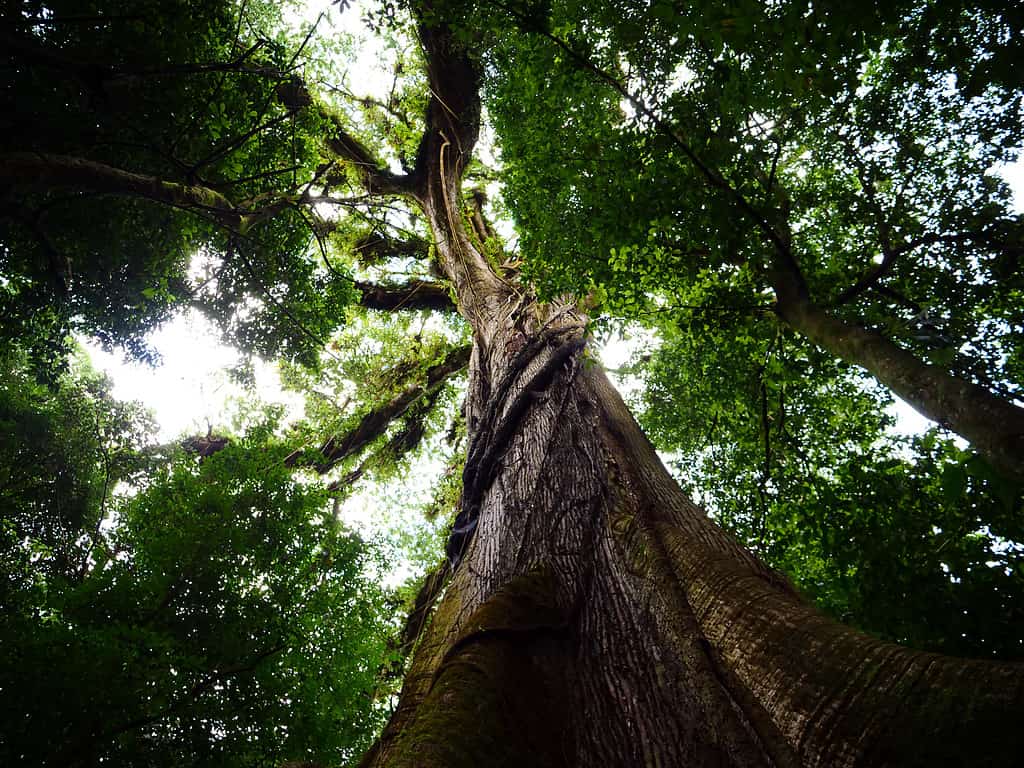
The canopy of a rainforest feeds on sunlight.
©Brad Schinkel/ via Getty Images
The Herbivores
Moving up the trophic levels, we have the herbivores, who are consumers that directly depend on the producers for life. Howler monkeys are just one example. They swing through the treetops eating leaves and fruits, and they play an important part in the rainforest food chain.
Another fascinating display of cooperation happens on a much smaller scale with leafcutter ants. These industrious insects collect and transport leaf fragments that are several times their weight. The ants don’t consume these leaf fragments directly, but instead, they serve as the substrate for cultivating fungi. In a way, the ants are actually performing agriculture. It’s a symbiotic relationship with the fungi, which becomes a primary food source for their colony.
There are even more herbivores along the lush riverbanks of the rainforest, like the capybara — the world’s largest rodent. They also depend on vegetation to survive while contributing to the food web themselves as a meal for predators.
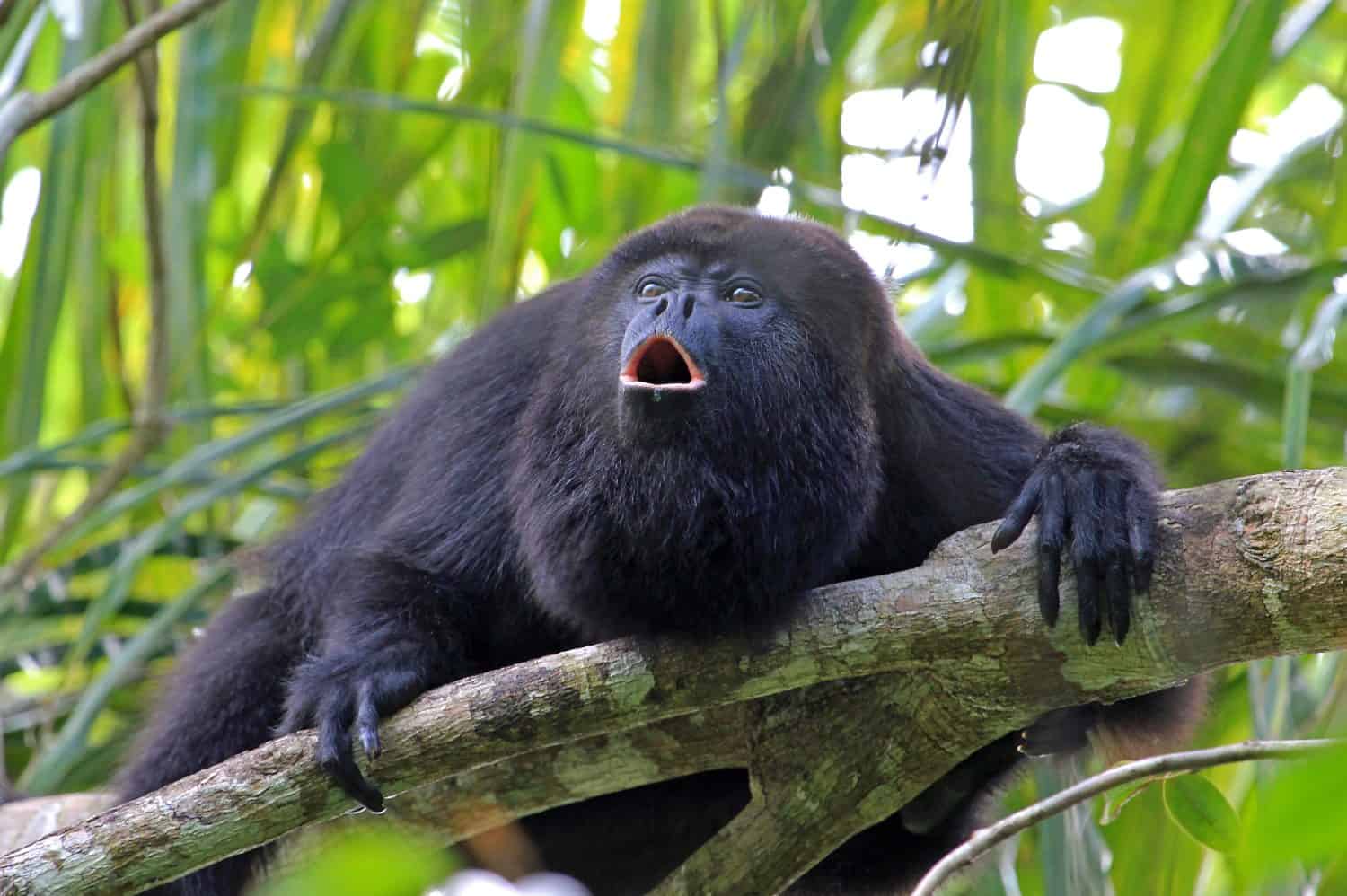
Howler monkeys are just one of the many herbivores of the rainforest.
©reisegraf.ch/Shutterstock.com
The Omnivores
Omnivores are versatile eaters, and they form the next layer in the rainforest food chain and web. The agouti (a relative of the guinea pig) is one of these omnivores, eating everything from fruits, nuts, and seeds to small insects. Their ability to adapt and fill their stomachs with whatever’s available makes them important connectors in the web.
These industrious animals bridge the gap between the plant and animal food chains, and they tend to have a few features in common. Omnivores typically have sharp teeth for tearing flesh and molars for grinding plant material. They may also possess an unusually adaptable digestive system, capable of breaking down both animal and plant matter.
Capuchin monkeys are also incredibly adaptable omnivores. They traverse the canopy for fruits, nuts, insects, and the occasional bird egg. They use stones and sticks to extract seeds or insects from hard-to-reach places.
And then there’s the coati, a member of the raccoon family. With a long, flexible snout, coatis forage for a varied diet consisting of fruits, insects, small mammals, and bird eggs. Their social nature often leads them to forage in groups, displaying cooperative behaviors as they search for food on the forest floor.
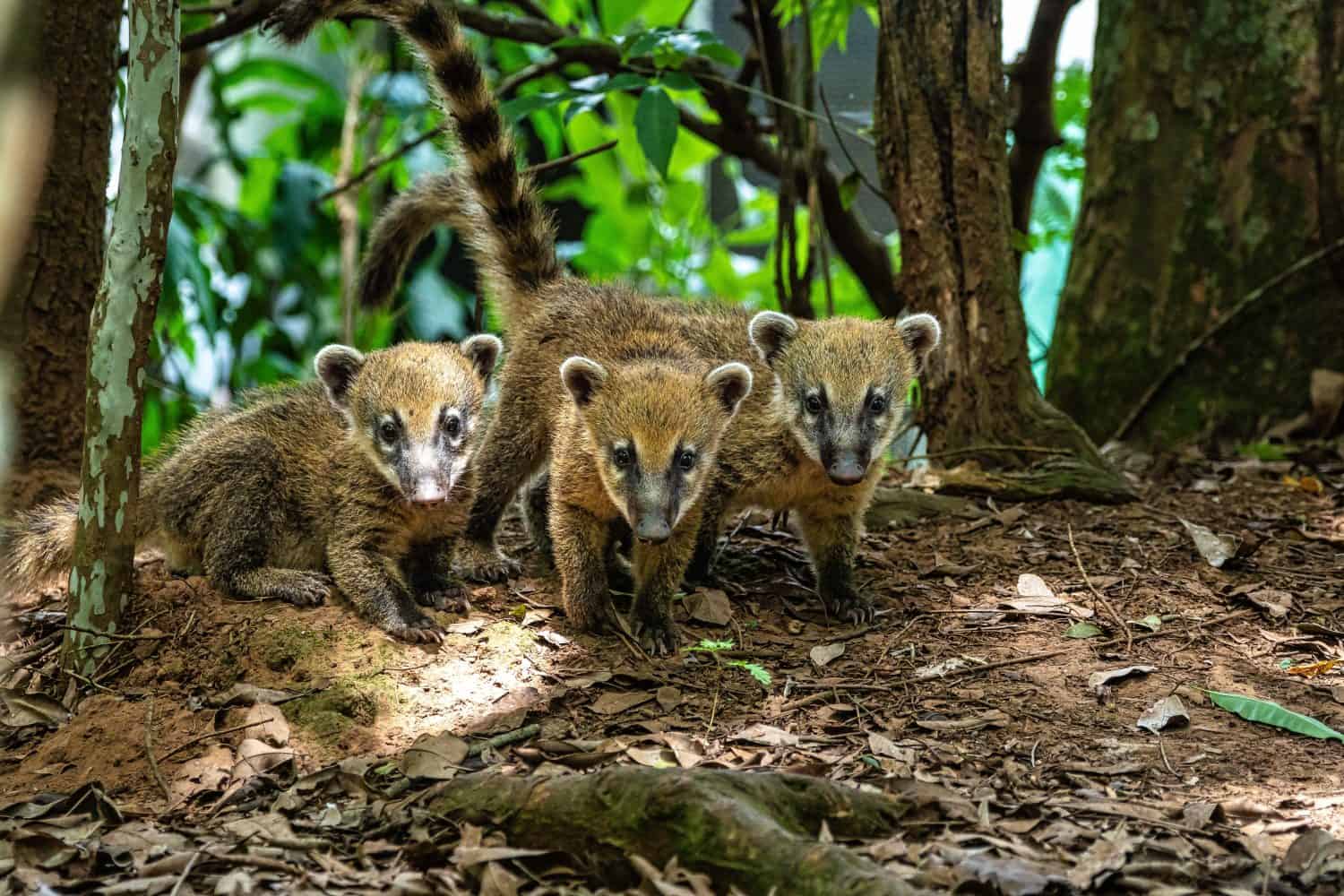
The coati is incredibly adaptable, with a diet of fruits, insects, small mammals, and bird eggs.
©RudiErnst/Shutterstock.com
The Carnivores
And then, at the top of your food chain, you have your predators — the carnivores. They are perhaps the most important members of the rainforest ecosystem and also the most threatened. These predators play a critical role in regulating prey populations and preventing overgrazing.
The jaguar feeds on a diverse menu of capybaras, tapirs, and caimans. Jaguars help regulate herbivore populations, preventing unchecked feeding on plants that could negatively impact the whole food web. Along with larger predators like jaguars and ocelots, there are many smaller wild cat species that also feed on small animals, like the margay and oncilla.
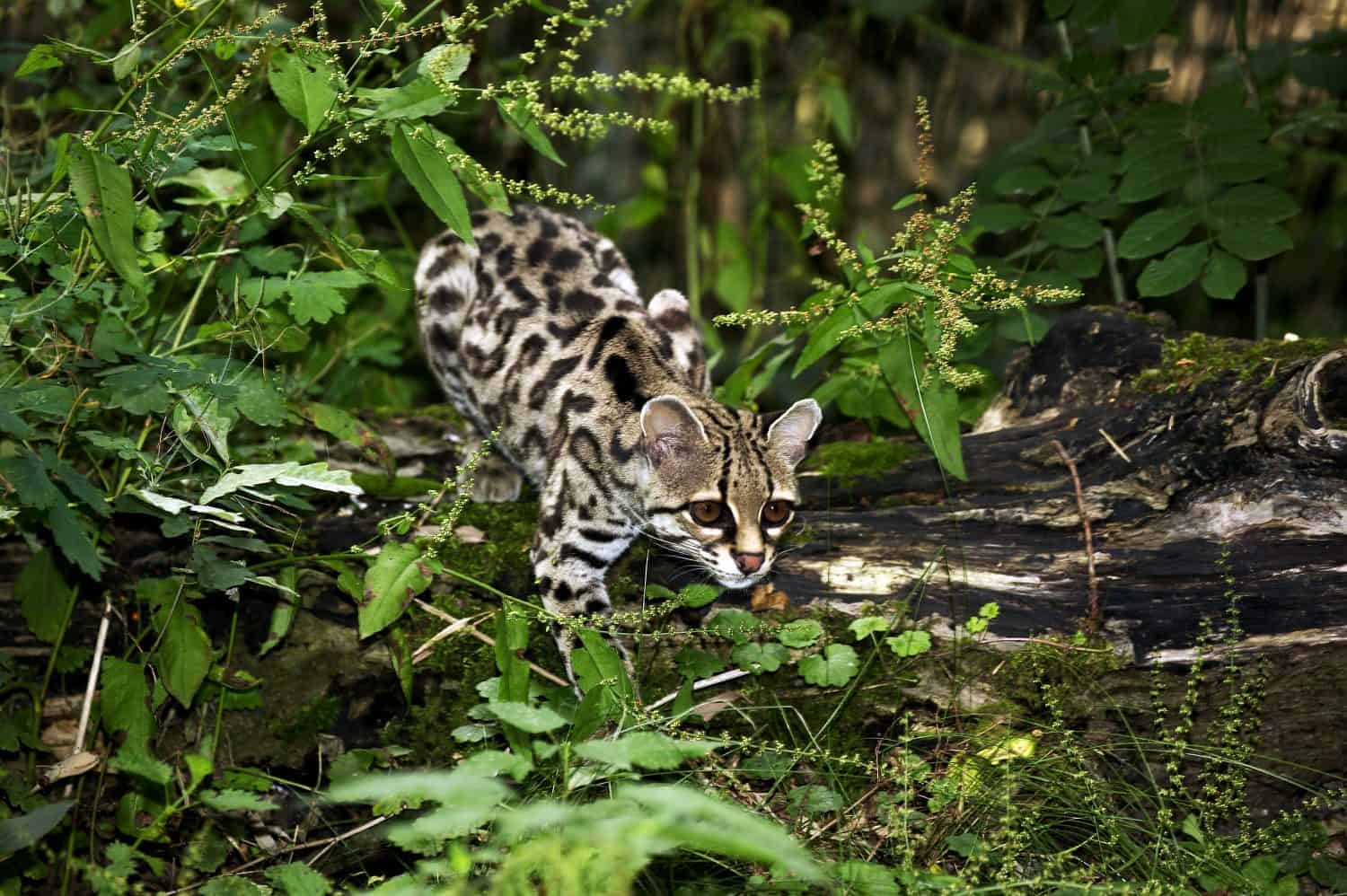
A margay hunts in the understory of the rainforest.
©slowmotiongli/Shutterstock.com
Anacondas control the populations of aquatic and semi-aquatic species, keeping the rainforest’s water ecosystem in check. Caimans also contribute to this work. Relatives of alligators, crocodiles and caimans feed on fish, amphibians, and small mammals.
The harpy eagle is another example of a top-tier predator. With formidable talons capable of crushing skulls, this bird of prey hunts from above the canopy. It preys on monkeys, sloths, and various avian species. The harpy eagle adds another layer of complexity to the rainforest food chain and web. It’s also a perfect example of the interconnected nature of predator-prey relationships.

A harpy eagle soars over the Amazon rainforest.
©Alves-Silva K. R/Shutterstock.com
Keystone Species
Keystone species are called such because of their importance to the ecosystem. They have a disproportionate impact on the rainforest food chain and web. Toucans are just one example. These colorful birds actually disperse seeds as they feed on fruits high up in the canopy. The scattering of seeds from their feeding habits serves to replant the forest floor. This contributes to the cyclical renewal of plant life.
This group isn’t limited to just animals, either. The fig tree is another keystone species since it is a main resource for a variety of animals and insects in the ecosystem. Birds, monkeys, and bats, as well as insects, feed on the fruit of the fig tree. This species is integral to the proper functioning of the entire food chain.
Bees and other pollinators — like butterflies and hummingbirds — are also keystone species. Their role in pollination ensures the reproduction of countless plants, including many food crops. The diversity and health of the rainforest is directly tied to bees and pollinators.
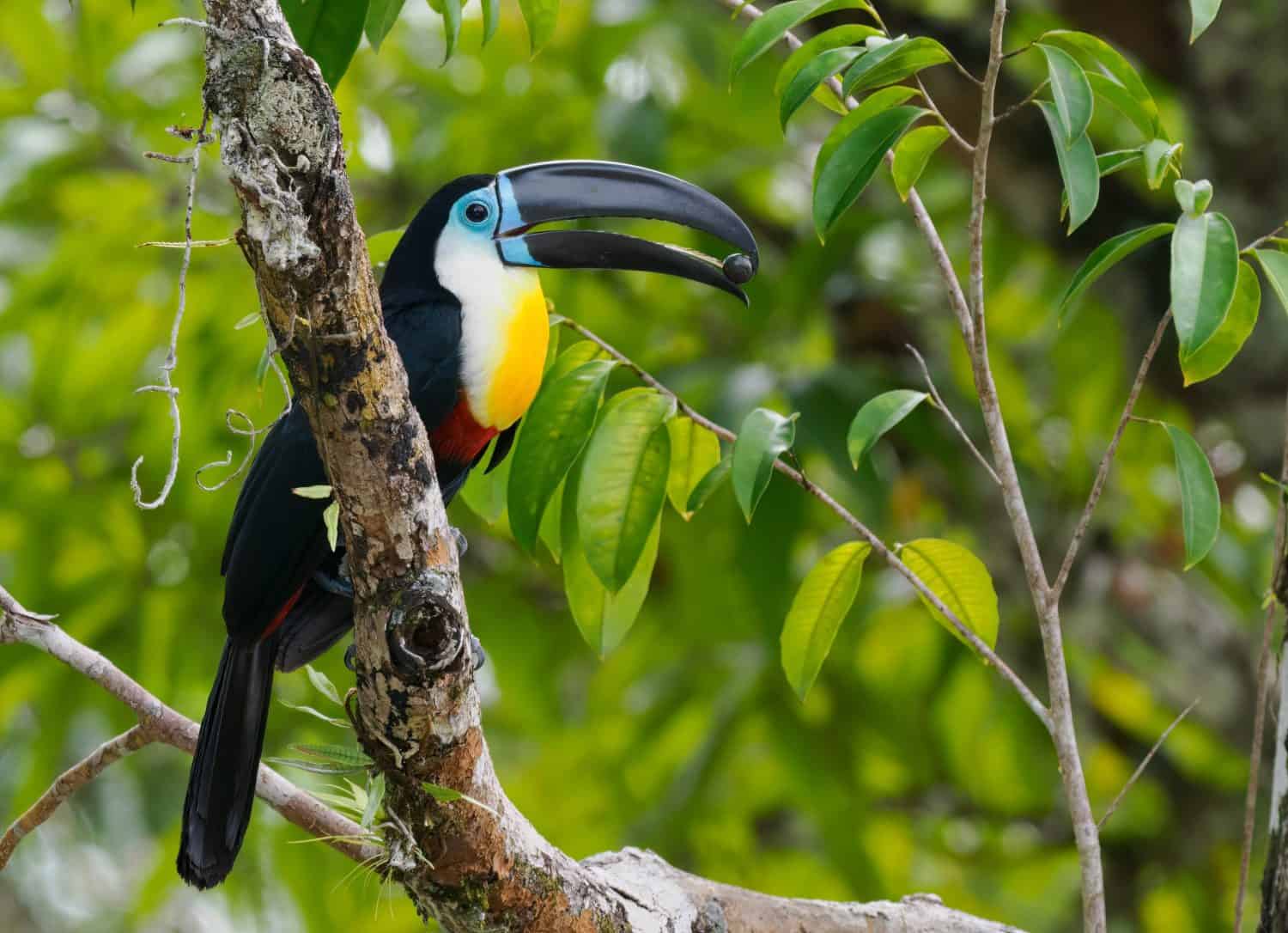
The toucan is one of the most important species in the rainforest.
©Peter-Hg/Shutterstock.com
The Understory
Beneath the canopy of trees, the understory presents a unique set of challenges and opportunities. Here, life thrives in shadows and limited sunlight filtered through the layers above. But that doesn’t make it any less busy. Creatures like the agouti and the elusive ocelot populate the understory, having adapted to the reduced light conditions.
Shade-tolerant species, such as ferns and certain orchids, also inhabit this space. Their ability to thrive in this environment contributes to the diversity and resilience of the rainforest. Fallen leaves, twigs, and other organic matter accumulate on the forest floor, which are passed off to the decomposers. Fungi, bacteria, and detritivores (like millipedes and earthworms) break down this organic material.
The understory is not only rich with botanicals, but it’s also a hotspot for diverse wildlife. Numerous species of insects, amphibians, and reptiles inhabit this layer. Take frogs, for example. They thrive in the moist conditions of the understory, utilizing fallen leaves for shelter and breeding sites.
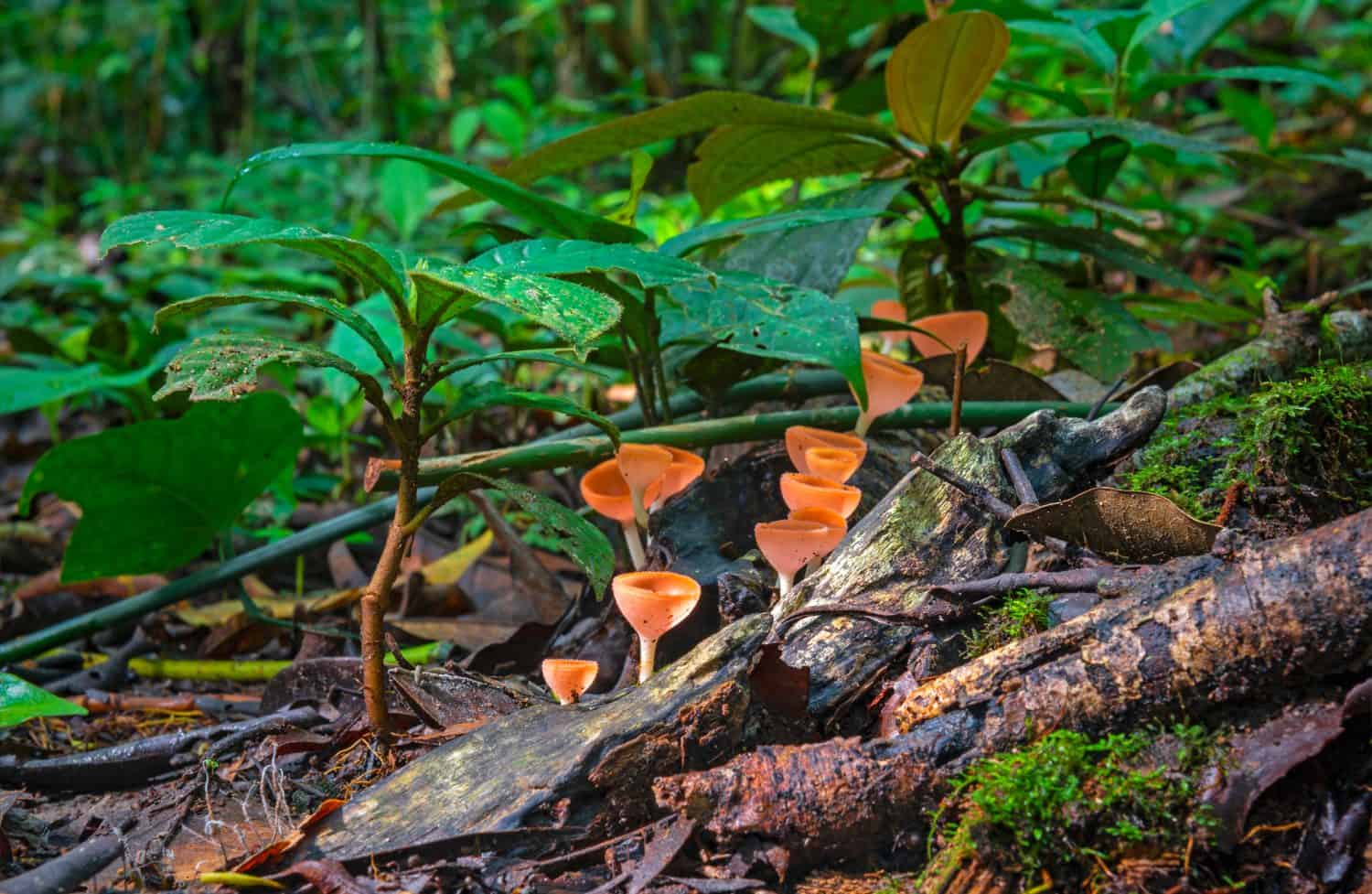
The rainforest floor is teaming with life, from ferns and orchids to fungi.
©SL-Photography/Shutterstock.com
The Nocturnal Players
Nocturnal creatures tend to hideout during the day, emerging only when the sun sets. These are not all predatory animals, but some are. Enhanced capabilities, such as acute hearing and a keen sense of smell, help them navigate and locate prey. Some nocturnal species use camouflage to hide from predators or ambush prey in the dimly lit environment.
Night monkeys are a nocturnal species, with their large eyes adapted for low light conditions. They typically eat fruits and insects. Bats are the ecosystem engineers, only coming out at night. Fruit bats, or flying foxes, consume nectar, pollen, and fruits, contributing to the ecological balance of the rainforest.
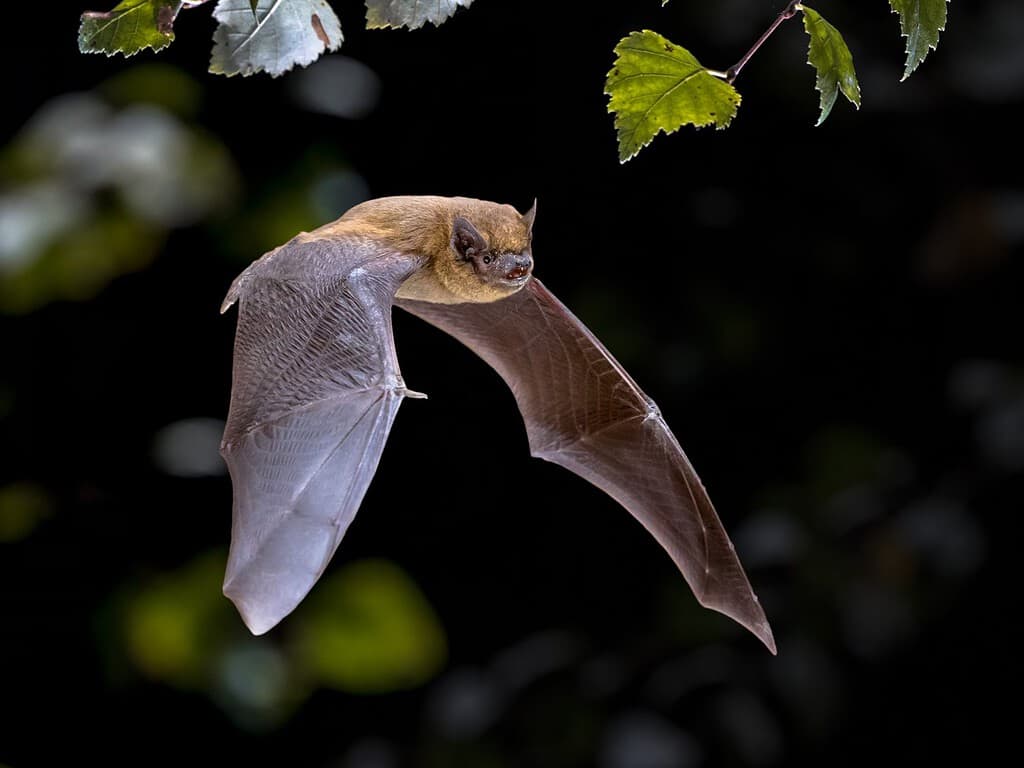
Bats are the engineers of the rainforest ecosystem, pollinating and spreading seeds.
©Rudmer Zwerver/Shutterstock.com
Some nocturnal species light up the darkness, such as luminous fireflies and beetles. They, too, contribute to the food web by pollinating and dispersing seeds, even in the nighttime hours. Snakes and certain species of lizards are also active nocturnal hunters. They have the ability to navigate through the undergrowth in search of prey without the help of sunlight.
Some plants in the rainforest have co-evolved with the nocturnal pollinators, like moths and bats. These plants often produce large, fragrant flowers that open at night. One such example is the moonflower. It’s a climbing vine with large, white, trumpet-shaped flowers that open only at night.
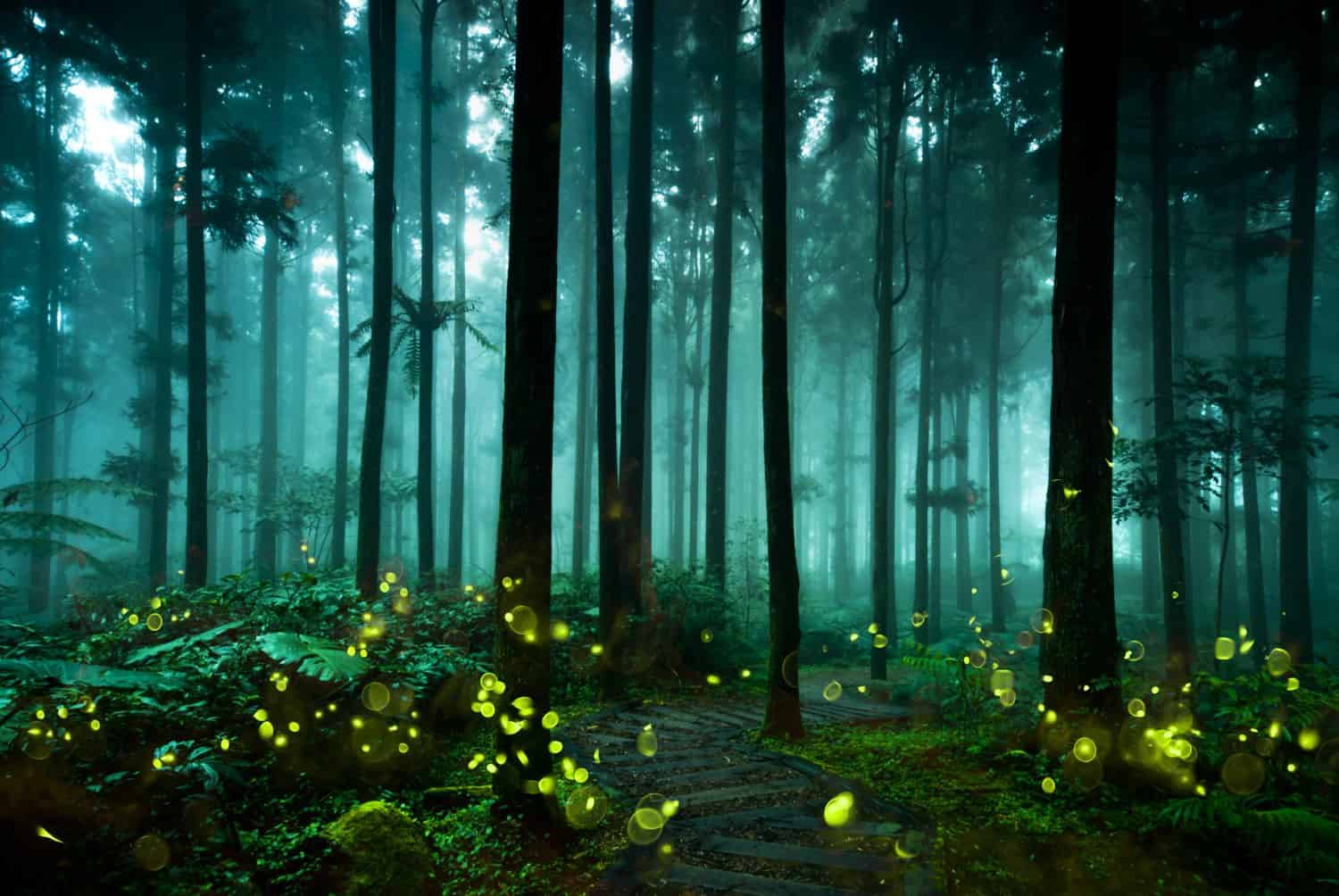
Fireflies and beetles light up the darkness with their luminescence.
©HTU/Shutterstock.com
The Decomposers
Someone has to clean up, and decomposers are the unsung heroes in the rainforest. Fungi, bacteria, and detritivores — like millipedes and earthworms — operate as nature’s natural cleaning crew. They may seem like small, insignificant bottom dwellers, but their role in the rainforest ecosystem is crucial. They break down organic matter, from fallen leaves to the remains of deceased organisms.
The decomposition process performed by these organisms makes the rainforest healthy. Decomposers help return vital nutrients to the soil by breaking down matter into a simpler form. They enrich the entire rainforest ecosystem.
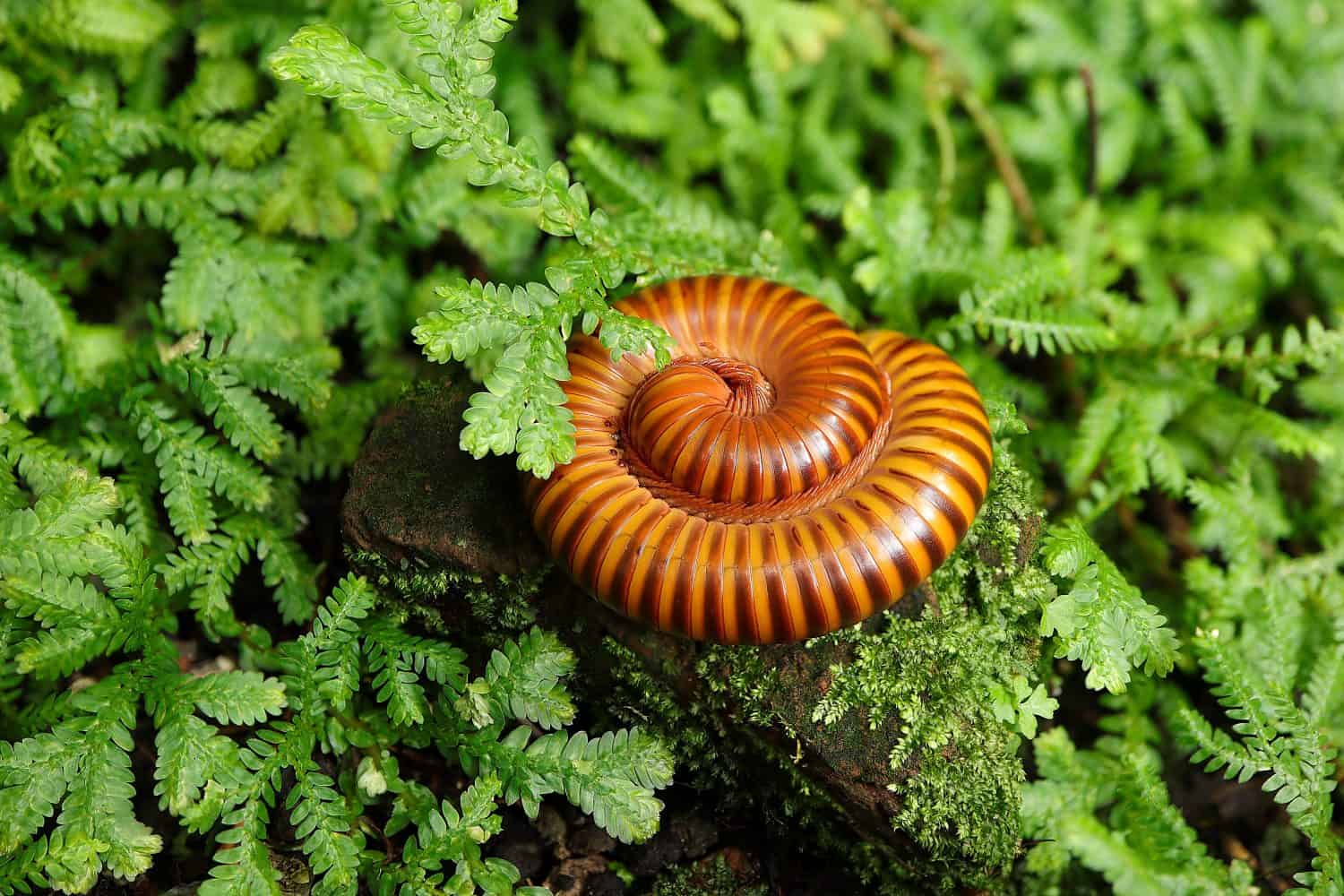
Even millipedes have an important part to play in the rainforest’s ecosystem.
©Yuphayao Pooh’s/Shutterstock.com
Mushrooms, molds, and other fungi are the primary decomposers in the rainforest. Using mycelial networks, fungi break down complex organic compounds. This helps the rainforest cycle nutrients, feeding the forest from the roots up.
From the towering trees to the decomposers returning nutrients to the soil, the rainforest is a living, breathing entity. Its health is key to biodiversity and interdependence. The balance of the rainforest requires a delicate equilibrium of thousands of species working together. Even the smallest ant makes a difference in this ecosystem, which is why the disappearance of one or more species makes an enormous impact.
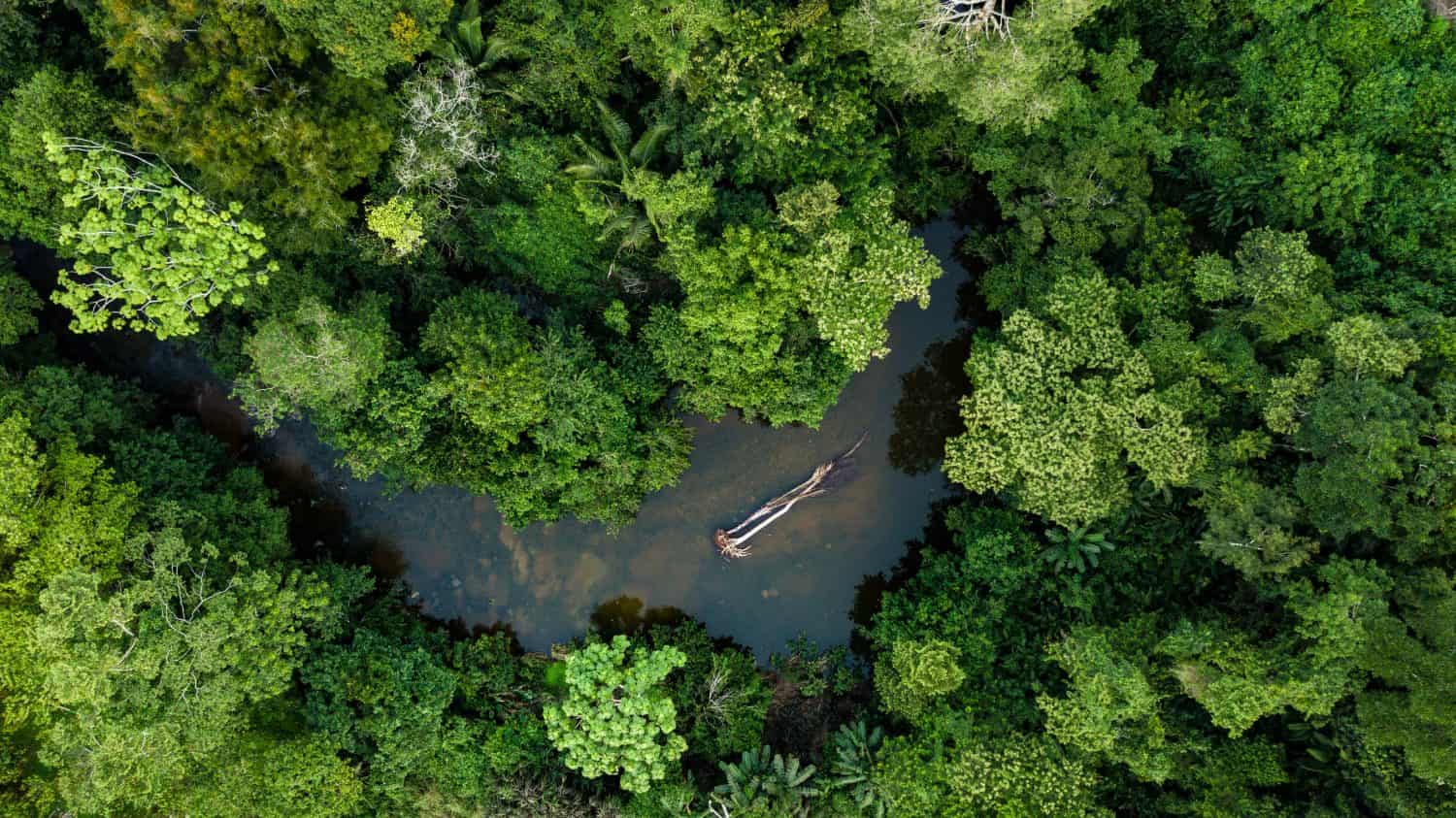
The rainforest features a complex balance requiring interdependence.
©qualtaghvisuals/Shutterstock.com
The photo featured at the top of this post is © jamenpercy/ via Getty Images
Thank you for reading! Have some feedback for us? Contact the AZ Animals editorial team.






